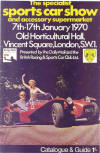~ Original Factory Material Lotus Seven 'S' ~
Only one Lotus Seven 'S' was made, the show car.
|
 |
CATALOGUE COVER - For the Sports Car Show at the Old Horticultural
Hall in January 1970. The car is the prototype Lotus Seven 'S', Reg. No.
TNG 7G. The driver and passenger are Ian Smith and his wife. Ian was
Founder and the first General Secretary for Club Lotus in 1956 and wrote
several books about the early days at Lotus including: "The First Ten
Years", "Lotus, The Story of the Marque" and "The Story of Lotus - Birth
of a Legend". Whilst there were no more Lotus Seven 'S' cars made the
more powerful Holbay modified 1600cc Ford Crossflow was supplied with
some cars. |

|
COCKPIT/DASHBOARD - The Lotus Seven 'S' prototype. Note AC Fuel gauge & Ammeter and Smiths Speedo, Tacho & combined Water Temp/Oil Pressure gauger. All is correct for a normal Series Three except for the finish of the dashboard and trim around the gear lever.
Also note the push-button radio! |

|
ENGINE BAY - The Lotus Seven 'S' prototype. A Holbay CFR engine with twin Weber 40DCOE2 and a nicely fabricated exhaust manifold. 120bhp
at 6,200rpm and 110lbs/ft at 5,000rpm was claimed. |

|
FRONT VIEW - The Lotus Seven 'S' prototype. Note: The Dunlop light alloy wheels and the damage to the rear offside wing. |
~ The Lotus Seven Twin-Cam 'SS' ~
Just 13 Twin-Cam 'SS' cars were made.
|
 |
SHOW CAR - The official line taken by the factory was
that the Twin-Cam engine would not fit in the Seven. Graham Nearn took a
car up to the factory in which the owner had fitted a T/C engine. 'SS'
stood for Super Seven. The result was the super luxury 'SS' car shown at
the 1969 Earls Court Motor Show, but only 12 orders were take.. |
|

|
ENGINE - The engine that was fitted was a specially unit
developing 126bhp by engine tuning specialists, Holbay of Suffolk.. |
|

|
REAR LIGHTS - These were specially inset into the wings.
Note: The wheels were mostly Dunlop pattern cast aluminium by GKN,
although the show car had Brand Lotus. |
|

|
DASHBOARD - This was finished in a silver colour and had
rocker type switches for the lights, windscreen wipers and heater. Note:
The specially made SS80 chassis made by Arch Motors has strengthening
features similar to (but not the same as) Caterhams of the 1990s. |
 |
WEATHER EQUIPMENT & INTERIOR TRIM - The soft top, side
screens and tonneau were colour co-ordinated and/or chosen by the
customer as was the thicker panelled seating and interior trim and
carpeting which were all of better grade materials. |

